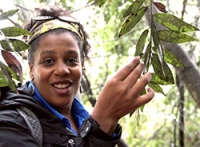Dr. Robert Bullard
Written by Davita Flowers-Shanklin, Volunteer Program Manager
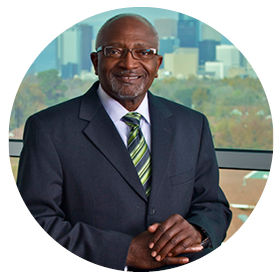 For me, when I think about Black people and the environment, my first thought is of Environmental Justice work. Black and Brown people have always been active in their communities, fighting against racism and for social justice. A lot of what our communists are working towards would fit within the environmental realm. It was always clear that the environmental activists and the social justice work happening around me were connected, even if the environmental movement didn’t talk about it. This connection drove me to look for people who did make these connections and Dr. Robert Bullard is a prominent one.
For me, when I think about Black people and the environment, my first thought is of Environmental Justice work. Black and Brown people have always been active in their communities, fighting against racism and for social justice. A lot of what our communists are working towards would fit within the environmental realm. It was always clear that the environmental activists and the social justice work happening around me were connected, even if the environmental movement didn’t talk about it. This connection drove me to look for people who did make these connections and Dr. Robert Bullard is a prominent one.
Known as the Father of Environmental Justice, Dr. Robert Bullard is currently a Distinguished Professor of Urban Planning and Environmental Policy at Texas Southern University. Bullard’s environmental justice work started in 1979 when he was an expert witness to a case that his wife was the lead attorney in. The case was agented the building of a landfill in a neighborhood in which they lived. In every aspect of location choice, where they lived was an unlucky option. It was a middle class suburban neighborhood, the only difference was that it was 83% African American. The case, Bean V. Southwestern Waste Management, was the first in the USA to use the Civil Rights laws to charge the waste management company of environmental discrimination. Through his work as an expert witness, Bullard conducted the first comprehensive account of ecoracism in the United States. It was found that African American neighborhoods in Huston were chosen for toxic waste sites at a much greater rate of non-black neighborhoods.
After this study, Bullard dove head first into an academic and activist career around Environmental Racism. In 1990 Bullard published Dumping in Dixie: Race, Class and Environmental Quality and the term Environmental Justice gained popularity. Bullard has published works on environmental racism, urban land use, sustainable development, industrial facility sittings, housing, transportation, climate justice, community reinvestment, disasters, emergency response, and community resilience, smart growth and regional equity. In 2013, he was the first African American to be honored with the Sierra Club John Muir Award. To learn more about Dr. Bullard, click here.
Shelton Johnson
Written by Ethan Bott, GIS & Field Data Coordinator
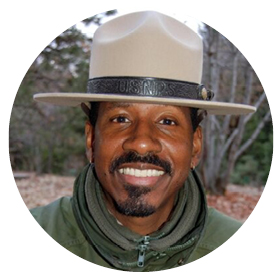 It has been a loose goal of mine to go to a national park at least once every year. Having done this for about the last 5 years, I have grown to appreciate and value our national parks with every passing year. At its core, national parks are a place for everybody of every gender, age, ability, race, and background. It is where we can find beauty and pride in our nation’s finest natural wonders that exist solely in America. They are a part of our identity and our history.
It has been a loose goal of mine to go to a national park at least once every year. Having done this for about the last 5 years, I have grown to appreciate and value our national parks with every passing year. At its core, national parks are a place for everybody of every gender, age, ability, race, and background. It is where we can find beauty and pride in our nation’s finest natural wonders that exist solely in America. They are a part of our identity and our history.
However, before I get ahead of myself, I want to stop and remind myself about the fact that my resources and abilities to visit these national parks is an immense privilege. It is also important to acknowledge that these spaces were stolen from those who called it home for hundreds of years. Without a doubt, the history of the national parks has been tainted by those that created them to those that have managed them. National parks have directly and indirectly excluded people of color and have a continued problem of lacking a diverse audience of any kind for numerous decades.
Alas, let me get to someone that has been working on creating a more diverse place in a predominately white space. I first heard about Shelton Johnson when I was in Yosemite National Park several years ago. Shelton Johnson is currently a park ranger with the U.S. National Park Service. Growing up in Detroit, MI, he always had dreams of the mountains and nature. That dream came to fruition when he applied to be a seasonal worker at Yellowstone National Park so that he could work on his writing in a quiet place as he had aspirations to become a poet. Little did he know that his first interaction with a 2,000 pound bison stepping off of a bus that day would change his life. Since then, Shelton has been working at national parks around the country as an interpreter. When he discovered the history of the Buffalo Soldiers and their service in patrolling Yosemite in the infancy days of the park, he knew he had to share that store with the public. Ever since, Shelton has been bringing to life the story of the Buffalo Soldiers in print, on camera, and in person. He has done extensive work in recreating the life and history of the Buffalo Soldiers; winning awards and praise from civic groups and governments alike.
Other than bringing to life an incredible story of African American soldiers being some of the first park rangers in America, Shelton has served as a role model and inspiration to so many young people of color. He has used his platform to connect people of color to the natural world and to create a safe place for them in our national parks. Having people of color represent themselves in these story telling positions is so crucial to the memories, perceptions, and ideals we carry with us in our lives. Thank you Shelton Johnson for the great work you are doing for our national parks!
Dr. Wangari Maathai
Written by Glenna Holstein, UEC Menomonee Valley Branch Manager
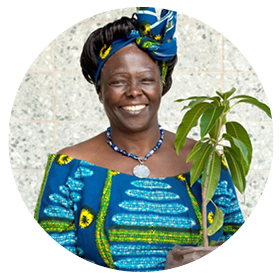 Wangari Maathai (1940-2011) was a Kenyan biologist and environmental justice visionary. She was the first Kenyan woman to earn a PhD, and she went on to chair the Department of Veterinary Anatomy at the University of Nairobi, chair the National Council of Women in Kenya, serve in Kenya’s parliament, and serve as served as Assistant Minister for Environment and Natural Resources. In 1977, Maathai founded the Greenbelt Movement, an Kenyan organization which “empowers communities, particularly women, to conserve the environment and improve livelihoods.” In response to worsening environmental and economic conditions in rural communities, the Greenbelt Movement galvanized women to grow and plant trees in order to remediate and stabilize the soil, store rainwater, and provide firewood for their communities. The Greenbelt Movement is still active today.
Wangari Maathai (1940-2011) was a Kenyan biologist and environmental justice visionary. She was the first Kenyan woman to earn a PhD, and she went on to chair the Department of Veterinary Anatomy at the University of Nairobi, chair the National Council of Women in Kenya, serve in Kenya’s parliament, and serve as served as Assistant Minister for Environment and Natural Resources. In 1977, Maathai founded the Greenbelt Movement, an Kenyan organization which “empowers communities, particularly women, to conserve the environment and improve livelihoods.” In response to worsening environmental and economic conditions in rural communities, the Greenbelt Movement galvanized women to grow and plant trees in order to remediate and stabilize the soil, store rainwater, and provide firewood for their communities. The Greenbelt Movement is still active today.
Maathai also authored four books and received the 2004 Nobel Peace Prize, among dozens of other awards. For more on Wangari Mathaai and her lasting legacy, click here.
Dr. Charles Nilon
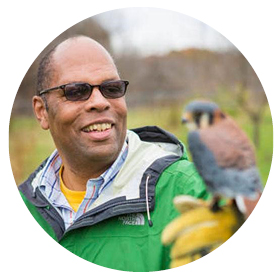 Written by Tim Vargo, Manager of Research and Community Science
Written by Tim Vargo, Manager of Research and Community Science
The field of Urban Ecology is a relative newcomer to academia, just like the Urban Ecology Center is relatively new compared to some of our peers. Because of this, many of the pioneering Urban Ecologists, like Dr. Charles Nilon, are still very active. Dr. Nilon embodies the heart of Urban Ecology Center programming because as a child, he spent a lot of time exploring the outdoors with his father. After receiving a B.S. from Morehouse College, an M.S. from Yale and a Ph.D. in Environmental Science and Forestry from the State University of New York, Dr. Nilon went on to become a professor in the School of Natural Resources at the University of Missouri’s College of Agriculture, Food & Natural Resources.
Dr. Nilon’s research considers the impact of urbanization on wildlife in cities such as Baltimore, Kansas City and St Louis and he recently partnered with colleagues from the MU School of Medicine on a project studying the kinds of open spaces where children are active.
Rue Mapp
Written by Gillian Spence, Corporate and Foundation Relations Manager and Tushunda Wright, HR Manager
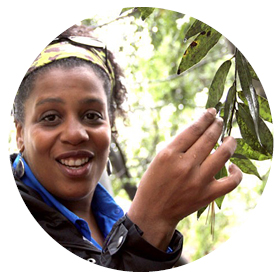 Outdoor Afro is at the forefront of helping more people, particularly African Americans, equitably reconnect with the natural world through Outdoor Recreation. Founded as a blog by Rue Mapp in 2009, the organization has grown to receive national sponsorship and is well regarded for its work in addressing the ongoing need for greater diversity in the outdoors. Outdoor Afro activates networks in nearly 30 states, led by trained volunteer leaders who facilitate activities such as hiking, biking, camping, environmental education, conservation stewardship, and more. Through planned activities, the organization reaches 30,000 people annually and amplifies those experiences through coordinated social and traditional media efforts that reach millions.
Outdoor Afro is at the forefront of helping more people, particularly African Americans, equitably reconnect with the natural world through Outdoor Recreation. Founded as a blog by Rue Mapp in 2009, the organization has grown to receive national sponsorship and is well regarded for its work in addressing the ongoing need for greater diversity in the outdoors. Outdoor Afro activates networks in nearly 30 states, led by trained volunteer leaders who facilitate activities such as hiking, biking, camping, environmental education, conservation stewardship, and more. Through planned activities, the organization reaches 30,000 people annually and amplifies those experiences through coordinated social and traditional media efforts that reach millions.
Outdoor Afro is changing the visual narrative, and inspiring access to the most pristine nature as well as urban nature, including local parks, trails, and open spaces. These activities promote not only a healthy lifestyle, they also help communities find healing, connect to black history found in many natural areas, and inspire an increased desire to protect vulnerable public lands for all to enjoy. Learn more about Outdoor Afro here.
Harriet Tubman
Written by Lucero Serna, Environmental Educator
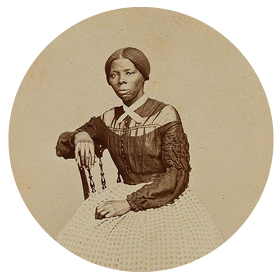 We remember Harriet Tubman as an abolitionist and a Conductor of the Underground Railroad. Rarely we do think of her as an environmentalist, but who understood the woods better than her, and other Conductors like her, who saw nature as a road to freedom?
We remember Harriet Tubman as an abolitionist and a Conductor of the Underground Railroad. Rarely we do think of her as an environmentalist, but who understood the woods better than her, and other Conductors like her, who saw nature as a road to freedom?
Harriet Tubman led runaway slaves through the Appalachian Mountains. Knowing the woods so well, she knew the streams they would cross, the birds they would hear, and the plants that would provide food to fill their bellies and remedies for ailments and injuries. She knew the woods so well, she never lost a single person on the many trips she made traversing the Underground Railroad. This journey was more than following the North Star; it was an outdoor journey that could only be accomplished with the guidance of a skilled outdoor survivalist. Today, Harriet Tubman would be considered a naturalist able to identify the herbaceous plants, trees, and birds of the Eastern United States.
During this Black History Month, let us find the time to honor the Black ecologists whose names were forgotten or whose ecological knowledge is rarely recognized but played a vital role in forming our U.S. history.
Who else belongs on this list?
We’d love to learn about more black environmentalists who inspire you! Comment below to help us grow our list. And, lastly: Just as we at the UEC often remind people that “every day is Earth Day”, we also want to remind everyone that every month is Black History month. The list above is nowhere near comprehensive, but acknowledges a few of the people to whom we owe a debt of gratitude for their environmental work.


